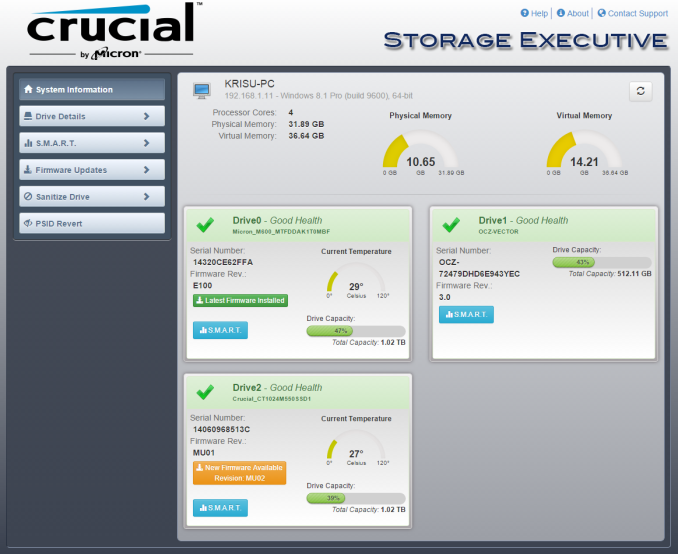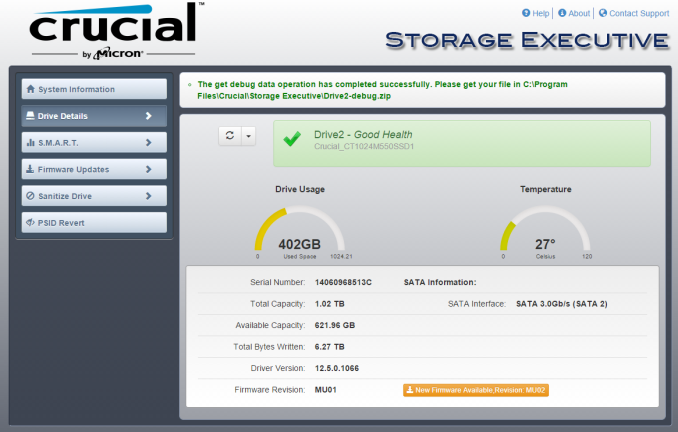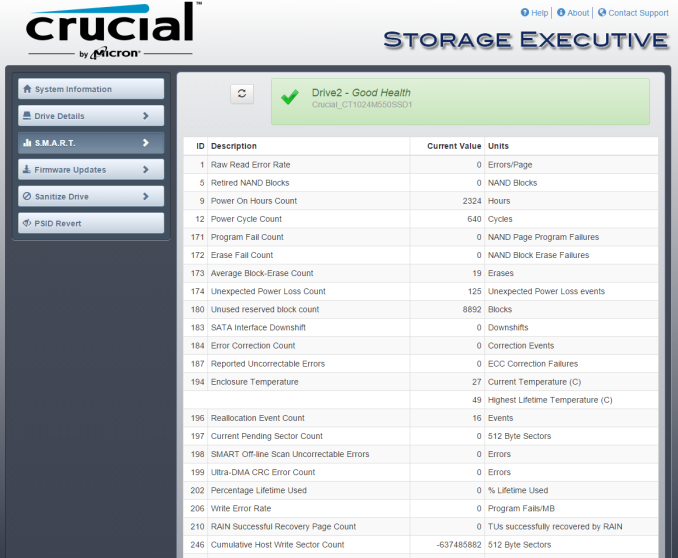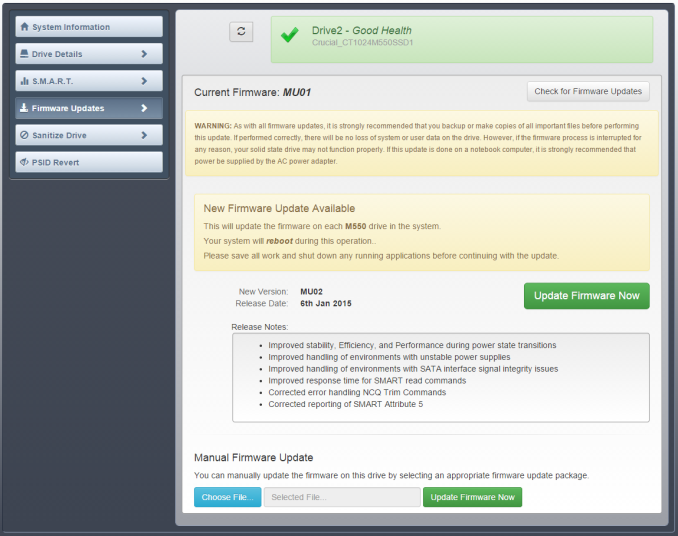Crucial BX100 (120GB, 250GB, 500GB & 1TB) SSD Review
by Kristian Vättö on April 10, 2015 1:20 PM EST- Posted in
- Storage
- SSDs
- Crucial
- Micron
- Silicon Motion
- BX100
- SM2246EN
- Micron 16nm
A Look at Storage Executive - Crucial's SSD Toolbox
One of the areas where Crucial has been lacking is the software. Nearly every SSD vendor provides some sort of software/toolbox for its SSDs nowadays, but until January Crucial had been the exception to the rule. I discussed this with Crucial/Micron last year and they understood their weakness on the software front, and also disclosed that there's a toolbox in the works. At CES the curtain was finally lifted when Crucial released its own toolbox called the Storage Executive.
Unlike the other toolboxes we've seen, the Storage Executive runs in the default browser. However, it still comes as an installer (which is quite large at 147MB for the 64-bit version) and has to be installed, but instead of running as its own window the Storage Executive utilizes the default browser for the interface. Since I'm not a software developer, I'm not sure if this is easier to implement versus a separate window, but honestly it doesn't really matter because a toolbox isn't something you need to keep open at all times, so Crucial's implementation works just fine for when it's needed.
The welcoming screen that's shown above shows the common tidbits of data that nearly all toolboxes show. This includes general information about the system such as the operating system and the amount of memory, along with slightly more detailed information about the installed drives (serial number, firmware version, temperature and used capacity).
The 'Drive Details' section shows more details about the drives, including the interface and driver version, but honestly it could use some additional details (e.g. life remaining). The drop-down button next to the refresh icon includes a 'Get Debug Data' feature that saves the drive's and system's data to a ZIP file that can then be sent to Crucial's support team for remote analysis of the drive and its potential issues.
The SMART tab includes the usual SMART data that can be read by numerous utilities.
The ability to easily upgrade the firmware is probably the most important feature in a toolbox and the Storage Executive is pretty straightforward with that. It automatically checks for updates and also features the release notes, so the end-user will know what has been changed in the newer firmware.
Drive sanitation is Crucial's code name for secure erase command, which will return the drive back to its factory state (i.e. all blocks are erased). There's also a PSID revert function that can be used to revert a TCG Opal encrypted drive back to unencrypted state using the physical security ID (i.e. PSID) that's printed on the SSD's label, which is very handy if you're dealing with encrypted drives because in case you lose the encryption key the drive will essentially become a brick as there's no way to access it. Obviously, PSID revert will erase all data in the drive, but the drive can then be repurposed. I did confirm that the PSID revert works and it doesn't require anything else but the PSID on the label.
All in all, from a functionality perspective, the Storage Executive is Crucial's first attempt at a software package, and it shows. It lacks features compared to what Samsung and Intel have at the moment, but it does offer the necessary features that one needs for troubleshooting and maintenance. That said, since this is the 1.0 version, there will be more features added in the future that should bring the Storage Executive closer to what the competitors are offering today.















67 Comments
View All Comments
Hulk - Friday, April 10, 2015 - link
Wow, that validates all of the other reviews I've been reading about this drive. Great performance, great value, and no TLC NAND worries. I'm getting one for my new laptop.Uplink10 - Saturday, April 11, 2015 - link
If you want a great value you better wait for a few months (maybe more than a few) till 3D NAND drives are going to come out from SanDisk, Micron, Intel, Toshiba. Then Samsing will not be the only company with 3D NAND drives and prices will probably going to come down.Harry_Wild - Saturday, April 25, 2015 - link
Thanks for the info! I will wait it out to get the best 3D NAND drives.Hace - Friday, April 10, 2015 - link
I'm kinda surprised you didn't draw more attention to the 850 EVO as a competitor, which is neck-in-neck with pricing.digiguy - Friday, April 10, 2015 - link
Yes, similar value for the money, and definitely more than the 840 EVO....Kristian Vättö - Friday, April 10, 2015 - link
I have to admit that I totally overlooked the 850 EVO as I was kinda assuming that its price would be higher. I put this review together on a very short notice as Ryan couldn't get the MacBook review finished for today, hence my mistake of not paying enough attention to the prices (even though I updated the table today...). Anyway, I've updated the conclusion to take the 850 EVO into account because as you said, the pricing is very close and it does provide a little higher performance.Hulk - Friday, April 10, 2015 - link
While the 850EVO is definitely a competitor for the BX100 the fact that it uses TLC NAND vs. MLC for the BX100 is a big deal for many people who aren't as yet convinced the 850EVO won't be affected by the read issue that is still a problem with the 840EVO. I realize the cell size for the 850 EVO's 3D NAND is much greater but as I wrote above many people, myself included, don't see the need to roll the dice on the 850EVO when the BX100 will provide basically similar performance.just4U - Friday, April 10, 2015 - link
The 850Evo is $20-$50 more on all models here in Canada. Not sure what stateside or Euro Pricing is like.Margalus - Saturday, April 11, 2015 - link
I just bought a 1TB EVO for $350 on Amazon, USArepoman27 - Saturday, April 11, 2015 - link
Kristian, hopefully you'll be helping Ryan with that MacBook review by covering the NVMe(!) SSD it ships with in depth. Looks to be a PCIe 2.0 x4 connected device dubbed "AP0256H", so possibly a semi-custom Apple controller based on the Marvell 88SS1093.